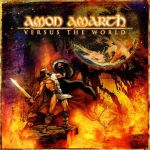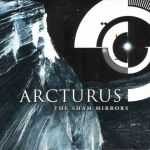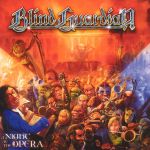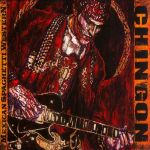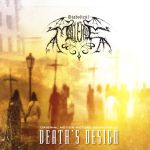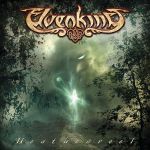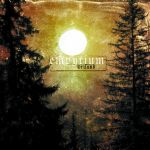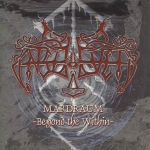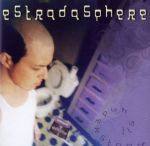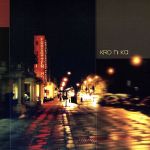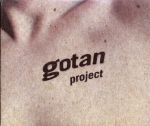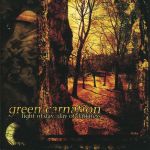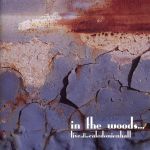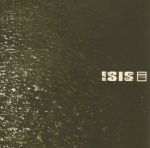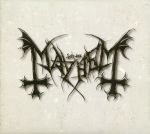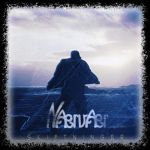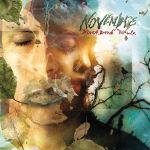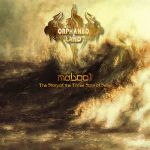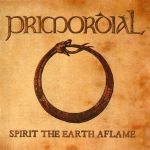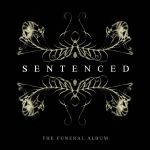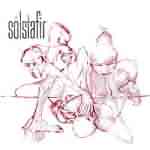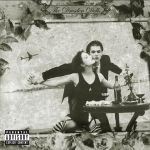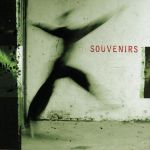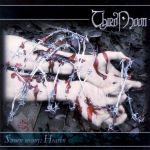My Top 30 Albums of the 2000s
January 31st, 2010I don’t think I’ve managed to make a "best of the year" list for any year this decade, but somehow I was able to put together a "best of the decade list". For no particular reason, I limited it to one album per band, and if everything else was equal, sided with the more "landmark" or "decade-defining" album.
The list ended up heavily skewed towards the beginning of the decade. That could be because I own a lot more music from that period, because that stuff has had more time to settle, or because there was simply better music. More stats in the wrapup.
For most bands that keep the exact same style from album to album, you figure by the time they get to their fourth album, they’re just going through the motions and putting out crappier versions of songs you’ve already heard. Instead, Amon Amarth defies the curse of the genre-band and crafts nine songs of deliberate melodic death metal that are exactly what you’d expect, but somehow, better in every way. More powerful ("Versus the World"), epic ("…and Soon the World Will Cease to Be"), and headbangingly-delicious ("Death in Fire"). Craftsmanship like this can make me think "genre" isn’t a bad word after all.
Largely given up for dead after 1997’s "La Masquerade Infernale", Arcturus makes a sudden and unexpected return five years later. Just when we were thinking we’d never hear Garm doing metal again, or even singing at all, he bursts out with the most freewheeling performance of his career. "La Masquerade Infernale" was one of the defining albums of the previous decade; Sverd and his crew are prevented from repeating that feat in this decade because the style remains largely the same, but since no one else was creating this form of dark-space-prog-metal, much less at this level, it’s still a standout of the aughts.
A long wait, many delays, and a truckload of hype about how many layers were required to construct this album. But the hype was justified, as Blind Guardian produced an album unlike anything we’d heard before. Initially the layers of sound were overwhelming, but over time it began to feel more natural, and the songs revealed themselves. And it ends up being the songs that make this album great; the basic melodies, rhythms, and song structures are at least as innovative and unique as the sound wrapped around them. One of the most amazing features of the album is the constant, simultaneous coexistence of independent lead guitar and lead vocal melodies, a trick almost no other metal band has even attempted. So it’s this core that holds the gold; if you stripped away all the layers and orchestration, we’d still have an album 95% as good as the one we got.
The album title promises something I didn’t even know I wanted so badly: a Latin take on Morricone-inspired spaghetti-Western soundtrack music. Perhaps only two of the songs fulfill that promise, but the rest of the album is even better. Birthed from the soundtracks to his films, Robert Rodriguez joins his searing electric guitar solos with the flamenco-inspired Latin rock from the band Del Castillo. Salma Hayek (who sings on one track) and Quentin Tarantino (who used a track in "Kill Bill") can’t be wrong. Pure rocking joy.
Once called an emo band, Cursive in 2006 made a brilliant record of angular prog-rock. With a horn section frequently blasting out and adding to the unsettling discord, each song still manages to be catchy-as-hell, and almost every one could stand on its own as a single (only one track breaks the 4 minute mark). But they’re also all linked together, wrapped with prologue and epilogue songs, telling vignettes from life in an unremarkable and undesirable mid-American town. With a special focus on religious hypocrisy, they’re the stories the Chamber of Commerce doesn’t want you to know about.
Blackheim’s (w/ Dan Swano!) three previous albums of melodic black metal were all very good (and amazingly different from his work in Katatonia), but despite various unique quirks, by and large they were fairly conventional. ‘Death’s Design’, in contrast, takes an entirely new approach to music composition. The 43 minute, 61-track album is a continuous piece of music, but it is divided into 20 "movements". Each movement is further divided into 1-5 "parts". This means that each part averages around 40 seconds, which is just enough time to get across one musical idea before moving on to the next one. The overall effect is as if 61 complete songs were originally written (or stolen), and then each one was whittled down to its core, removing all the boring repetitive stuff and simply keeping the best hook. It’s like getting 61 dollops of sour cream without having to eat any of the baked potato. But at the same time, the parts of each movement are thematically linked, even if they don’t quite form conventional "songs". And then the movements all flow together as an uninterrupted composition. Maybe it’s still ahead of its time, because nine years later I still don’t know of anyone who has done anything similar.
A power-metal band with some folk influence releasing their debut album in 2001? It’s a genre that one would expect to have been long played out, but Elvenking is naive enough to think they can make a classic for the new decade, and partially because of that naivete, they do. In an era where templates and formulas were becoming increasingly important, Elvenking managed a production that’s almost amateur. It seems no one told them not to throw in those random death growls, no one told them not to hop from one idea to the next so recklessly, and no one told them their guitars didn’t have sufficient balls-n-chunk. So luckily, we ended up with this album brimming with life, spirit, and energy, and the exciting feeling that the whole thing could go flying off the rails at any second.
If not for this album, 2004’s "Back to Times of Splendor" would have made it on this list. So to almost completely abandon that successful style and forge something entirely new was quite a risk. But it paid off, for with "Gloria", they created an even more decade-defining album than they had with BtToS. The album has a completely unfamiliar yet cohesive style, so the sound is clearly built out of a unique and well-defined vision, rather than by throwing random shit at the wall and seeing what sticks. Cold yet melodic, crushingly heavy yet danceable, with a pervasive East German paranoia. Their third album, if it ever comes, has been my most-anticipated release for four years now.
At first I thought ‘Weiland’ was merely an annoyingly-packaged 3-disc retread of ‘Where at Night the Wood Grouse Plays’, which itself was a copy of Ulver’s ‘Kveldssanger’. Acoustic evening songs that make you fear the forest that lies beyond the light of the campfire. Though the style is the same, in execution, it goes well beyond its inspirations. Using only acoustic instruments and few words, they’re able to generate the tension and terror of the most frightening and uncensored stories from the Brothers Grimm. But there is also wonder and beauty to be found. Technically, the night forest is only the inspiration for part 2. Part 1 is songs from the moor, and part 3 is the water spirits (evoked by addition of piano). But all envelop you in the feeling of being alone in the dark natural world. ‘Weiland’ is proof that mimicking can be but the first step in the student exceeding the master.
Enslaved did a whole lot of things right in this decade, but they did a lot of things right in the previous decade too. This is their nexus album. It currently sits right near the middle of their nearly 20-year career, and forms the crossroads of their stylistic evolution. ‘Mardraum’ is the only album which combines the cold, brittle, and decapitating black-metal guitar tones of their first decade with the psychedelic and prog leanings of their second decade. Really, the sound of the album is something truly special. There’s great sonic separation between the rumbling and pounding rhythm section and the penetrating guitars that ride atop, but both combine to create a mystical whirlwind of fury that’s somehow incredibly clear and well-defined. And the songs are pretty great too.
As the first 30 seconds of the first song on the first album from Estradasphere come whirling about you like a dervish, you instantly sit up and take notice. "This may be a band to be reckoned with!" This suspicion is strongly confirmed by fact that the tour-de-force continues for another 19 minutes, particularly as they effortlessly cross from gypsy music to bluegrass to straight jazz to lounge funk to death metal. Like a national tragedy (but better!), I still remember where I was when I first heard this. The rest of the album continues much the same, while adding additional oddities such as Nintendo music and new-age-ambient. This scattered approach means that some stuff hits the target better than others, but when they get the drums/bass/guitar/violin/saxophone rollicking along in synchrony, there are few bands than can touch them.
After their elaborate, layered, epic-prog-death masterpiece ‘Senyaan’, Forgotten Silence first peeled away the keyboards (on ‘Ka Ba Ach’), then most of the growled vocals and the the drums (on ‘Bya Bamahe Neem’, which answers the question "what does drumless death metal sound like?"). On ‘Kro Ni Ka’ the female vocals finally went by the wayside, but drums and keyboards returned in exchange. So we ended up with epic-length 4-piece instrumental prog-rock, yet another unpredicted twist in Forgotten Silence’s career. If I listened more to this kind of music, I’d know what 70s bands they’re ripping off and wouldn’t like it nearly as much, but my mind still associates it with the mystical Forgotten Silence magic.
‘La Revancha del Tango’ does such a beautiful job of mixing tango music and electronic rhythms that it seems a wonder we had to wait until 2001 for this merger to happen. Shouldn’t it have been obvious? A bunch of bands were quick to follow, and giving birth to a new subgenre always makes for good award-bait. Sultry, smoky, and sophisticated, this is an album that gave atmosphere to many a late night this decade.
Tchort’s hour-long, single-song, epic-metal masterwork. It’s the most impressive execution of an artistic vision that I’ve ever seen. The only thing I’m aware of that’s on the same level is Peter Jackson’s film adaptation of "Lord of the Rings". For both, the resume was so thin, the goal was so high, the challenges were so great, and the opportunities for failure were myriad. So when they not only failed to fail, but actually succeeded so brilliantly, the success seems further magnified by the memory of the risks they overcame. If this was a ranked list, this album would probably be #1.
Maybe it’s cheating to include a live album on a list like this, but I’m doing it anyway. Because this is a pretty unique live album from a great band. Both band and audience knew that it was the final thing In the Woods… would do together, so it’s truly a document of a monumental event. They put together this special show where they played most of their discography, roughly in chronological order. With the four download-only tracks I added to my "special edition", it comes to nearly three hours of music, including their masterwork ‘Omnio’ played in its entirety. Most of the renditions are fairly similar to the studio versions (which is a feat in itself, given In the Woods…’s lush and textured sound), but it’s often these versions that I reach for now when I need my In the Woods… fix.
This is another album where, if it gave birth to a new subgenre (post-metal, in this case), it must be pretty good. Even better, seven years later this album is still at the top of the heap. It sounds like it could be the finely-tuned end result of years of post-metal trial-and-error, rather than the first experiment. Sure, there were influences, but post-metal as we know it today was largely defined by this album. Everything about it, from the layered instrumental construction, to the expansive but propulsive song structures, to the loud but enveloping sound, came out fully-formed and just right.
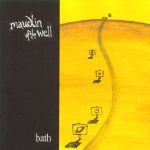
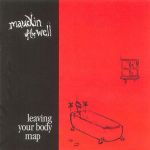
maudlin of the Well – Bath / Leaving Your Body Map (2001)
http://www.youtube.com/watch?v=jX2oUNNDSfw
Ok, this is two albums, but they go together. I could write a pages-long description of this band’s sound (and I have!), talking about the wide range of musical styles, the bizarre changes, the variety of instrumentation, etc., but that wouldn’t tell you a thing about why these albums are on this list. To be sure, the style and the weirdness are one of the things I really like, and it’s what first drew me into the band. But to me, all that is just a means to an end. This is in stark contrast to a lot of other "kitchen sink" bands, who seem to throw in everything but the kitchen sink just because they’re able to. maudlin of the Well does it for a purpose. They are able to conjure up a very complex, very specific, yet very undefinable mood, feeling, and atmosphere, and communicate it all to the listener. Whether anyone else feels the same thing, or whether what I feel is anywhere near what the band intended, I have no idea. I also have no answer to the question of how the band was able to figure out the bizarre formula that would produce such an unexpected result. I could never reverse-engineer it in a million years.
In the 90s, I never figured I’d like a Mayhem album, much less have one end up as one of my favorites of the 00s. But then, this isn’t really a Mayhem album; it’s a Rune Eriksen (Blasphemer) solo album, where he simply hijacked the Mayhem name for marketing purposes. Amazingly, it’s still black metal, even though it sounds very little like any type of black metal we’d ever heard before. The sonic mess of the original Mayhem is replaced with surgical, razor-sharp guitar playing, and Hellhammer’s clinical and martial V-drums. A completely new approach to coldness and grimness.
Kristiansand, Norway (pop. 80,000) must have the highest density of musical geniuses in the world. Tchort from Green Carnation, the mysterious Botteri twins from In the Woods…, and heck, throw in the Solefald guys too. And then we add Terje Sagen, the man behind Naervaer. To execute his vision of "pure mood music", he brings in a bunch of the In the Woods… crew to help out, most notably ItW vocalist Jan-Kenneth Transeth (ok, it’s his 3rd appearance on this list, add him to the musical geniuses too). It’s largely acoustic, sometimes there are "songs", sometimes it’s more soundscapes, though it’s too persistent to ever become "ambient". Whatever it takes to evoke a mood. I’ve loved it for nearly a decade now, but camping at night this year on the high desert plateau of the American Southwest, it blew my mind wide open.

Nick Cave & the Bad Seeds – Abattoir Blues / The Lyre of Orpheus (2004)
http://www.youtube.com/watch?v=SMv2vm6D-9w
Nick Cave & the Bad Seeds spent the 90s getting softer and quieter, and then, improbably, spent the 00s getting harder and louder. On their way back up near the middle of the decade, for their 13th album, they produced this out-of-nowhere masterpiece. With some exceptions, ‘Abattoir Blues’ captures the loud and boisterous side, while ‘The Lyre of Orpheus’ covers the quiet and atmospheric side. However, neither side is a retread of past work; choirs and piles of instruments give either a power or a depth that the Bad Seeds had never reached before, but none of those additions have any chance of burying a re-lit Nick Cave, the not-exactly-religious preacher leading his carnival congregation.
In the mid-90s, a band named Opeth released a couple of brilliant albums. The had invented a riff-less form of metal, led instead by intertwined melodic guitar leads, overlaid with a mix of clean and growled vocals. It was melodic death metal, without being Melodic Death Metal. The pace was more relaxed, the atmospheres deeper, and the journey more free-form. In short, it was genius. But by the end of that decade, Opeth had thrown that all away. Luckily, Novembre, a contemporary of Opeth’s from the early 90s, smoothly stepped in to take up the fallen mantle. From the Mediterranean rather than the Baltic, their sound is necessarily warmer and more Romantic than Opeth’s, and the songs more concise. An Opeth clone would not make this list, and Novembre is clearly not that; instead, they created an alternate vision from similar influences, and ‘Novembrine Waltz’ captures that emotional resonance I’d been waiting for.
In 1994, as a small group of bands in Sweden were experimenting with a new sound that would come to be known as "melodic death metal", a band from Israel, Orphaned Land, had already invented their own regional version of the same on their debut record, ‘Sahara’. Two years later on ‘El Norra Alila’, they advanced that sound considerably and released perhaps the most complete synthesis of metal and local cultural influence ever put to tape. After such an auspicious and groundbreaking beginning, the expectations for their third album were unreasonably high from the start, and only grew as the years dragged on, to the point where ‘Mabool’, if ever released, would have no hope of matching them. But against all odds, it did. A whole new sound for the third time (smoother and more rounded, with an increased keyboard emphasis, and bigger hooks), but the core remains the same: "oriental" riffs and melodies on the guitars, seamlessly intertwined with local instrumentation, and the most explicit synthesis of the Abrahamic religions thus far, as the three are tied together with the myth of The Flood.
Though drawing heavily from melodic black metal, Primordial’s overall sound is so unique and characteristic that they could almost be credited with creating a new subgenre themselves, if only other bands had the ability to follow them. It starts with the guitars, where instead of distinct metal riffs, we get a huge, swirling, droning sound full of harmonics playing off each other. Add Nemtheanga’s impassioned declarations, exhortations, and tribulations, and you have some of the most powerful and evocative "folk metal" you’ll ever hear, without ever needing a fiddle or tin whistle. Primordial had been creating this same music in previous decade, and continued throughout the 00s, but this album was the first that matched pain and suffering with the strength of iron and the blaze of fire.
On ‘Book M’, Secret Chiefs 3 took a trip that started at the eastern edge of Europe, and pushed on towards The Orient, picking up musical ideas and instruments along the way. Back home in California, they fused the ancient sounds and melodies with the modern western world, augmenting them with dense electronics, unsettling glitchy rhythms, and metallic storms of distortion. You could call it folk metal if you wanted to, but make sure the person you’re talking to has an expansive mind, for it comes from a completely different pedigree than Skyclad or Orphaned Land.
After 15 years evolutionary life, Sentenced made a conscious decision to end it. However, unlike nearly every other band-breakup in the history of rock music, their end was marked not by an unceremonious press release or quiet fadeout, but by a carefully-planned funeral album. Though the melodic, radio-metal style is largely the same as the one they had finally settled on for their last few albums, it’s that external circumstance that makes this album incredibly unique. Always fascinated with topics of death and suicide, ‘The Funeral Album’ gives these topics the extra depth that can only come as a response to real life. It seems that the tendency would be to freeze up in the face of such self-consciousness, but somehow Sentenced turns it into an extraordinary advantage. Nowhere is this effect stronger than their final song, "End of the Road". Feeling the pressure to say something dramatic and meaningful for your final words would seem to lead to either an overwrought mess or complete denial of the situation, but instead, Miika Tenkula’s 2-minute mournful-but-uplifting guitar solo ends Sentenced’s life as perfectly as you could possibly imagine.
‘Masterpiece of Bitterness’ is an album that could only come from this decade. It needed to be preceded by the development of black metal and forays into the epic and experimental by metal bands of the 90s, and be of an era where it was even conceivable to synthesize those sounds with that of post-rock, psychedelic-rock, and even garage-rock. This diversity of influence allows an incredible dynamic range, even though the final synthesis is distilled to a simple and cohesive guitars/bass/drums sound, adorned only by the full-throated melodic screams. Opener "I Myself the Visionary Head" captures the full extent of that range, with its title and 20-minute length referencing the epic and pretentious, while the 15 minute repeated riff, led by a dirty and distorted bass guitar, references the rest. A unique vision discovered when I thought metal was running out of such things.
Amanda Palmer is such a gifted singer/songwriter that she likely would have made it on her own, but when she found drummer Brian Viglione and they formed a duo and named it ‘The Dresden Dolls’, it basically guaranteed their success. Mostly dark and brooding, but with occasional bursts of pop sunniness, the range covered by piano, voice, and drums makes you wonder what other bands need all those instruments for. Lyrics are endlessly clever and shockingly personal, and cover an even greater emotional range than the music. From this DIY debut, to Roadrunner Records (who released the technically superior ‘Yes, Virginia’), to the red carpet at The Golden Globes, with lots of excellent live performances in between, The Dresden Dolls are probably my band-of-the-decade.
In 1995, The Gathering released ‘Mandylion’, which invented female-fronted metal as we know it today. That’s worthy of a prize in itself, but by the end of that decade they had left that domain to their followers and created their second landmark album, the sprawling modern epic, ‘How to Measure a Planet?’ The uninspired, conventional follow-up (‘If_Then_Else’) led me to believe that two masterpieces was more than we really ought to expect out of a band anyhow, but then they shocked with ‘Souvenirs’. How can a former metal band release the darkest album of their entire career as their seventh album? The final track, a stunning duet between Anneke and Ulver’s Garm, seems obvious in retrospect, as ‘Souvenirs’ is a clear atmospheric relative to Ulver’s ‘Perdition City’: The Gathering’s trip-rock is still more conventional than Ulver’s ambiances, but both are music for the 3am streets of modern Europa.
Melodic death metal may have peaked in Sweden by the turn of the century, but in an unknown corner of Austria, Thirdmoon was just getting good. Sonically, they’re quite independent from Gothenburg or any other band, I think mostly due to their pummeling rhythmic density. It takes some excellent songwriting skill to integrate that level of heaviness without making it sound unnecessarily brutal, but Thirdmoon is up to the task. Occasionally incorporating acoustic guitars that play right along with blasting metal is another trick they use to add texture. Their previous two albums are also excellent, but ‘Sworn Enemy: Heaven’ has their most diverse stream of neverending hooks and riffs, all stitched together in a way that seems natural and not-at-all "prog". In fact, the sense of identity and focus from Wolfgang Rothbauer’s songwriting seems so strong, it feels as if Thirdmoon may have found their way here even if Sweden had never existed.
This is Ulver’s fifth album, and the fifth complete re-invention of their sound. By now, you figure they must have some serious skills. The first three, you could dissemble and say they were all somehow related to "black metal", and then on their fourth, anyone has a chance of getting lucky when going whacked-out experimental. But ‘Perdition City’ proves that there’s a lot more than luck at work. Capturing the atmosphere of a dark forest at night and turning it into sound (on ‘Kveldssanger’) was impressive enough, a feat that would cause most bands to either rest on their laurels or retire immediately. But for the same band to invert that feat four years later, capturing a cold city as sound, the atmospheric opposite of the natural forest, seems almost impossible. To be fair, Kristoffer ‘Garm’ Rygg was the only common link between the two efforts, so maybe he’s simply a good manager of the musical talent of others, rather than a musical genius himself. But given that this is his third appearance on this list (tying Mista Transit), I’m thinking a ‘musical genius’ tag might be well-deserved.
